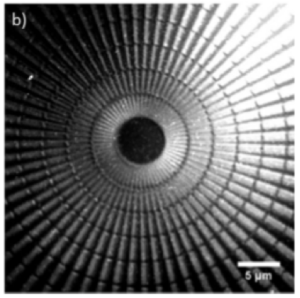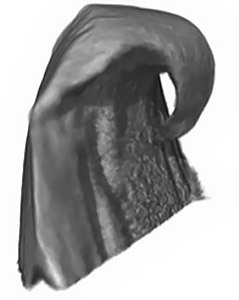X-ray microscopy
The X-ray optics limits the bandwidth of the spectrum, thus a high brightness and relatively monochromatic X-ray source is needed. The conventional laboratory-based X-ray microscopes often use high-power rotating-anode sources. The drawback of this setup is the high loss of flux, since the acceptance angle of the optics will strictly limit what radiation that can become useful. A MetalJet source offers a sharp, high-intensity Kα line from Gallium emitted from a small focal spot, making a considerably larger fraction of the flux useful in the optics setup. This higher brightness makes broad applications possible also on compact sources.
Application examples for X-ray microscopy
The periodic line patterns at the inner of a Siemens star, with 150 nm lines and spaces, can be resolved with the X-ray microscope based on the MetalJet D2 source. The image was taken with a Fresnel zone plate as objective.
From the same publication, a volumetric rendering of the CT of a bent ~ 4 µm tip of the bend tip of a damaged injection cannula with X-ray microscope based on Excillum’s MetalJet source. The voxel size was 147 nm.
Unless otherwise stated, pictures and content is published under license for CC-BY.


